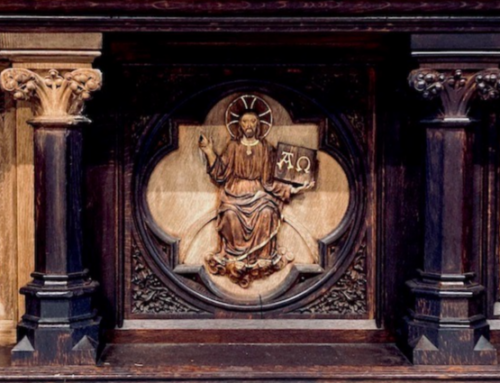It’s true that when trying to understanding Scripture we need to establish an analysis of concrete terms. But if we aren’t careful, we just might explain away the beauty of descriptive language the Bible. Saint Augustine of Hippo encountered the same issue, and not just among his youngest students.
 In humanities coursework, we often train students to first identify formula and pattern. Lists and examples abound—symbolism, allegory, metaphor, simile, personification. We insist there is greater meaning. We demand analysis.
In humanities coursework, we often train students to first identify formula and pattern. Lists and examples abound—symbolism, allegory, metaphor, simile, personification. We insist there is greater meaning. We demand analysis.
It’s true that we need to establish a foundation of both concrete terms and appreciation in our students. But sometimes this means that analysis turns into a recipe, something that must be done in a certain order, something that at the same time can remove the delight of the reading. If we aren’t careful to tend to our training, we just might explain away the beauty of descriptive language in history, literature, and the Bible. In the third century, Augustine of Hippo encountered the same issue, and not just among his youngest students.
In On Christian Doctrine, Augustine did not view figurative language as a rote formula, but rather as an apt tool that expanded Scripture’s meaning. Taking great delight in the imagery and balance of plain and figurative language, he persistently argues against those “hasty and careless readers” who interpret the Bible in a literal, one-dimensional way.
According to Augustine, the literalists mentioned in Book III interpret Scripture “in a carnal manner . . . in subjection to the flesh by a blind adherence to the letter.” It’s as if they are unable to access their God-given soul and spirit to read and study in a deeper way, since they are limited to the finite human mind. This humanistic pursuit was apparently rampant enough in Augustine’s day that he had to pin it as a common practice in contrast to his view.
Another point of contention is that the literal scholar also may accept as truth what he has been exposed to in the beliefs of his community or church, “what is sanctioned by the custom of his companions.” Augustine’s concern then was that those readers, lacking common sense, would oppose what Scripture clearly commands, especially if it were contrary to the general teaching around them. Thus, Scripture at that point must be “figurative,” and so they dismissed the instruction of the Word. Again, this literalist practice limits a fuller understanding of Scripture, much like constricting our ability to man’s mind only—“It is surely a miserable slavery of the soul to take signs for things, and to be unable to lift the eye of the mind above what is corporeal and created, that it may drink in eternal light.” As Augustine’s argument progresses, he reiterates his discussion of signs and symbols and proposes several helpful solutions to those who would misread or limit themselves.
First, Augustine would ask the literal scholars to acknowledge the use of tropes in Scripture. Describing the Greek grammarians and their advantage in understanding Scripture, he also adds that most men are well aware of “all these tropes . . . as a matter of liberal education” and “ordinary speech.” Augustine assumes that identifying things like parable, allegory, or enigma are not only commonly studied, but also common in speech.
As a second point in Book II, he lays out a balance of “plain” and descriptive language in Scripture, acknowledging its use of varied style. Augustine’s example of a lone verse from Song of Solomon illustrates how the image of a single simile brought him “the greatest pleasure” with an abundance of thought in contrast to a plain statement. Yet the Holy Scripture doesn’t rely on imagery alone. Augustine carefully points to this balance, where it can be “pleasanter in some cases to have knowledge communicated through figures.” Summarizing this stance, he says that the Holy Spirit “with admirable wisdom and care for our welfare, so arranged the Holy Scriptures as by the plainer passages to satisfy our hunger, and by the more obscure, to stimulate our appetite.” Clearly then, his advice to the literalist would include an admonition to delve deeper into descriptive passages and to work hard to discover meaning.
Finally, in his commentary on true eloquence in Book IV, Augustine asserts that the prophets concealed much “under a metaphorical style, which the more completely they seem buried under figures of speech give the greater pleasure when brought to light.” He cites the opening lines of Amos and clarifies that this passage was not “composed by man’s art and care, but it flowed forth in wisdom and eloquence from the Divine mind.” In essence, the required interpretation relies on revelation from God Himself since He authored the very words, including their figurative use. Those then who would oppose this metaphorical style or refuse to interpret it are essentially denying God as author.
For the inexperienced or literal scholar, Augustine created a test, a standard if you will, to illuminate this literal mind. Augustine shows us, “Whatever there is in the word of God that cannot, when taken literally, be referred either to purity of life or soundness of doctrine, you may set down as figurative.” It becomes an “either-or” choice. He asks us to “carefully turn over in our minds and meditate upon what we read till an interpretation be found that tends to establish the reign of love. Now, if when taken literally it at once gives a meaning of this kind, the expression is not to be considered figurative.”
Overall, to “meet the objections” of those who disagreed with his approach to studying the Scriptures, Augustine hoped to provide method and insight to “earnest students.” He never claims to understand all, but relies upon and advocates the grace of God.
The Imaginative Conservative applies the principle of appreciation to the discussion of culture and politics—we approach dialogue with magnanimity rather than with mere civility. Will you help us remain a refreshing oasis in the increasingly contentious arena of modern discourse? Please consider donating now.
The featured image is from Montauban Cathedral, Tarn et Garonne, France – Augustine of Hippo by Marc Arcis. Monumental statue in limestone ordered in 1715. Absidial chapel on the left, and is licensed under the Creative Commons Attribution-Share Alike 4.0 International license. Courtesy of Wikimedia Commons.







Thank you for this recommended reading.
Myself, as a very poor student find several passages so confronted as to seriously question the validity of the reported Word.
A simple example might be Saul’s disobedience to commit Genocide for which he paid severely.
The economist in me understands the option of slavery as long as Saul was not the personal beneficiary.